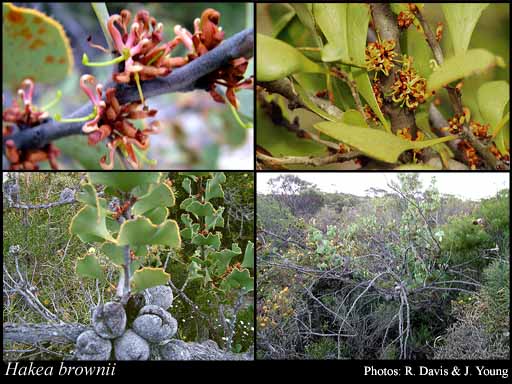- Reference
- Lehm., Pl.Preiss. [J.G.C.Lehmann] 1: 569 (1845)
- Conservation Code
- Not threatened
- Naturalised Status
- Native to Western Australia
- Name Status
- Current
Lignotuberous shrub, 0.4-2.5 m high. Fl. cream-brown, Nov. White or grey sand, gravel.

Scientific Description
Shrubs, 0.4-2.5 m high; branchlets glabrous or hairy. Leaves alternate, (28-)40-80 mm long, (23-)35-80 mm wide, glabrous; lamina flat, clearly widest above the middle, once divided, shallowly divided. Inflorescences axillary, brown; pedicels 2-6 mm long. Perianth 5-7 mm long, hairy; ovary glabrous; pistil 6-9 mm long, pollen presenter oblique, style glabrous. Follicles 35-50 mm long, 40-45 mm wide, corky tetrahedral projections (on external surfaces of fruit) absent; seed 25-30 mm long (including wing), 25-30 mm wide, the wing continuous. Flowers in September, October or November. Occurs in the South-west (SW) Botanical Province(s), in the Geraldton Sandplains (GS), Swan Coastal Plain (SWA), Avon Wheatbelt (AW), Jarrah Forest (JF) or Mallee (MAL) IBRA subregion(s).
Distribution
- IBRA Regions
- Avon Wheatbelt, Geraldton Sandplains, Jarrah Forest, Mallee, Swan Coastal Plain.
- IBRA Subregions
- Dandaragan Plateau, Katanning, Lesueur Sandplain, Merredin, Northern Jarrah Forest, Western Mallee.
- Local Government Areas (LGAs)
- Broomehill-Tambellup, Bruce Rock, Carnamah, Coorow, Dandaragan, Dumbleyung, Katanning, Kent, Kondinin, Kulin, Lake Grace, Narrogin, Pingelly, Three Springs, Victoria Plains, Wagin, Wickepin, Williams, Wongan-Ballidu, Woodanilling.